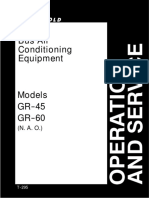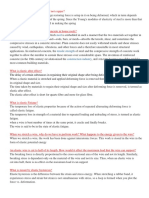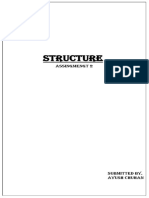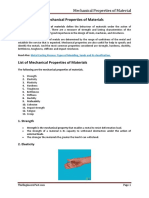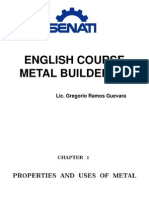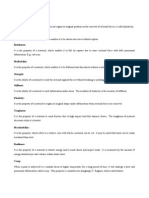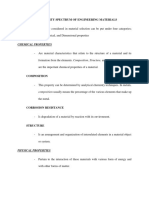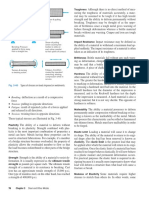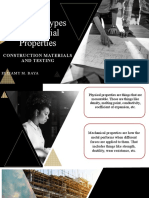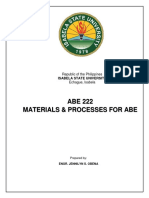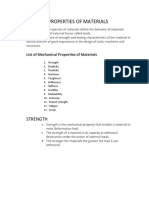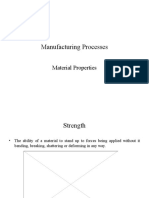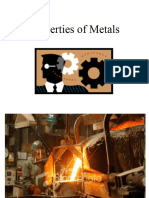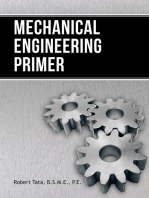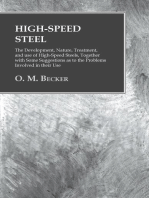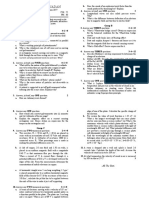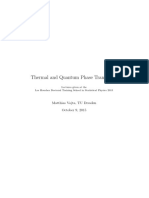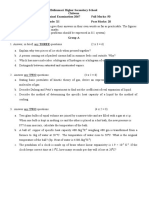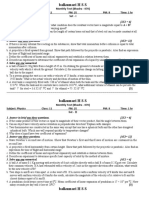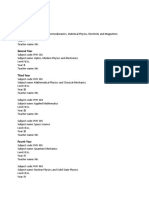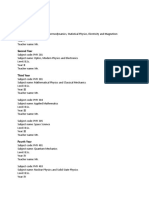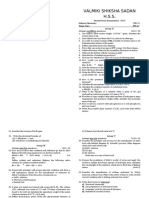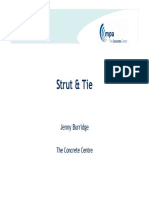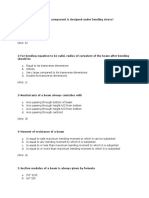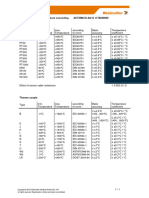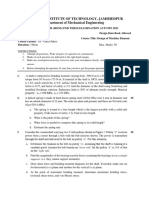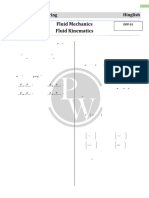Concrete Steel: Elasticity
Concrete Steel: Elasticity
Uploaded by
Rabindra Raj BistaCopyright:
Available Formats
Concrete Steel: Elasticity
Concrete Steel: Elasticity
Uploaded by
Rabindra Raj BistaOriginal Title
Copyright
Available Formats
Share this document
Did you find this document useful?
Is this content inappropriate?
Copyright:
Available Formats
Concrete Steel: Elasticity
Concrete Steel: Elasticity
Uploaded by
Rabindra Raj BistaCopyright:
Available Formats
Elasticity
Why are springs made of steel and not copper?
A spring will be better one, if a large restoring force is setup in it on being deformed, which in turm depends
upon the elasticity of the material of the spring. Since the Young's modulus of elasticity of steel is more than that
of copper. Hence steel is prefferred in making the spring
Why are steel rods embedded in concrete in house roofs?
Reinforced concrete, concrete in which steel is embedded in such a manner that the two materials act together in
resisting forces. The reinforcing steel—rods, bars, or mesh—absorbs the tensile, shear, and sometimes the
compressive stresses in a concrete structure. Plain concrete does not easily withstand tensile and shear stresses
caused by wind, earthquakes, vibrations, and other forces and is therefore unsuitable in most structural
applications. In reinforced concrete, the tensile strength of steel and the compressive strength of concrete work
together to allow the member to sustain these stresses over considerable spans. The invention of reinforced
concrete (in the 19th century) revolutionized the construction industry, and concrete became one of the world’s
most common building materials.
What is elastic after effect?
The delay of certain substances in regaining their original shape after being deformed within their elastic limits.
When a elastic material is stretched and applied deforming force is removed then it take some time to return to
its original shape and size.
The time taken by materials to regain their original shape and size after deforming force is removed, is termed as
elastic after effect.
The elastic after effect is short for quartz fibre and more for glass fibre.
What is elastic Fatigue?
The temporary loss of elastic properties because of the action of repeated alternating deforming force is
called elastic fatigue.
The temperory loss in strength of a material due to repeated loading and unloading of stress, is termed as elastic
fatigue.
when a wire is bent number of times at the same point, it cracks and finally breaks.
The wire is said to be in the state of elastic fatigue.
When we stretch a wire, why do we have to perform work? What happens to the energy given to the wire?
When we stretch a wire, the work has been done against interatomic forces. This work is stored in the wire in the
form of elastic potential energy
An elastic wire is cut to half of its length. How would it affect the maximum load that the wire can support?
The breaking force is directly proportional to the cross-sectional area of the wire and not its length. Similarly,
breaking stress is dependent only on the material of the wire and not its size. Thus, when an elastic wire is
cut into half, there is no effect on the maximum load it can support
What is meant by elastic hysteresis?
Elastic hysteresis is the difference between the strain and stress energy. When stretching a rubber band, it
experiences stress and strain but strain is not simultaneous with stress, so a loop is formed when you plot the
force vs. deformation.
What are ductility and brittleness of a solid?
Ductile material: They are materials that can be plastically twisted with no crack. They have the tendency to hold
the deformation that occurs in the plastic region. Common ductile materials are copper, aluminum, and steel.
Brittle material: A brittle material is one that will break as opposed to bending. Brittle materials absorb very
small energy before fracture. Examples: Ceramics such as glass, cement, concrete, etc. and Stone
What are strength, rigidity, hardness, malleability and ductility of a solid substance?
Strength
Strength is a measure of a material’s resistance to permanent deformation or complete breakage under stress.
Strong materials are able to resist heavy impacts, and are able to absorb and distribute large amounts of energy
without breaking.
Rigidity
Rigidity, also called stiffness, is a measure of elasticity, and represents a material’s resistance to permanent
deformation. Rigidity is closely related to strength, but differs in that brittle materials can be rigid, but not
strong, and softer malleable metals, such as lead, can be strong, but not rigid. Rigidity is a material’s resistance
to bending, whereas strength is a material’s resistance to breakage.
Rigidity is measured by finding the Young’s modulus of a particular material.
Hardness
Hardness is a material’s resistance to surface deformation. Harder surfaces are subjected to greater internal
stresses, and have a tendency to increase in brittleness, often relying on unhardened internal material for their
structural strength. As hardness is only a resistance to surface deformation, it is often only improved at surface-
level, as treatments which significantly increase core hardness can also cause brittleness. Hardness can often be
easily altered by surface treatments such as case-hardening or plating.
Malleability
Malleability is a substance's ability to deform under pressure (compressive stress). If malleable, a material may
be flattened into thin sheets by hammering or rolling. Malleable materials can be flattened into metal leaf. ...
Many metals with high malleability also have high ductility.
Ductility
Ductility is the physical property of a material associated with the ability to be hammered thin or stretched into
wire without breaking. A ductile substance can be drawn into a wire. Examples: Most metals are good examples
of ductile materials, including gold, silver, copper, erbium, terbium, and samarium
Why a rope of bridge is made from the cluster of strings but not from a rod?
Wire rope is several strands of metal wire twisted into a helix forming a composite "rope", in a pattern known as
"laid rope". Larger diameter wire rope consists of multiple strands of such laid rope in a pattern known as "cable
laid".
Why a rope of bridge is made from the cluster of strings but not from a rod?
To increase strength
You might also like
- Calculation Sheet For Tank - API 620 12th EdDocument48 pagesCalculation Sheet For Tank - API 620 12th EdHamid Mansouri72% (18)
- Carrier Bus Air Conditioning Unit Model GR 45 GR 60 Operation Service Manual Pub T295Document56 pagesCarrier Bus Air Conditioning Unit Model GR 45 GR 60 Operation Service Manual Pub T295Sharyn TurnerNo ratings yet
- Elasticity SAQDocument2 pagesElasticity SAQRabindra Raj BistaNo ratings yet
- EmmDocument18 pagesEmmrajasamygopalNo ratings yet
- AyushDocument4 pagesAyushsatabdi palNo ratings yet
- Mechanical Properties of MaterialDocument3 pagesMechanical Properties of MaterialAngel Ange P PhiriNo ratings yet
- Mechanical Properties of MaterialsDocument4 pagesMechanical Properties of MaterialsMuhangi ChristopherNo ratings yet
- 3 Mechanical Properties of MetalsDocument23 pages3 Mechanical Properties of MetalsJeffersonTalanNo ratings yet
- Metals and Their Properties (Report)Document48 pagesMetals and Their Properties (Report)Emmanuel BlancaverNo ratings yet
- Drilling Operations l3 NotesDocument21 pagesDrilling Operations l3 Notesishimwe kwizera willyNo ratings yet
- Workshop AnswersDocument10 pagesWorkshop AnswerscollegememotagorebhawanNo ratings yet
- How Does Rust FormDocument5 pagesHow Does Rust FormRathnakrajaNo ratings yet
- Mechanical Properties of MaterialDocument9 pagesMechanical Properties of Materialmj03127477706No ratings yet
- Chapter 2Document56 pagesChapter 2safeer ahmadNo ratings yet
- 17 Types of Material StrengthDocument3 pages17 Types of Material StrengthKristine Jade ReanzaresNo ratings yet
- Introduction To Composite Materials: Mr. S. G. KulkarniDocument66 pagesIntroduction To Composite Materials: Mr. S. G. KulkarniNavneet SoniNo ratings yet
- 22 Mechanical PropertiesDocument18 pages22 Mechanical PropertiesJASONNo ratings yet
- Mechanical Properties of MaterialsDocument4 pagesMechanical Properties of MaterialsBoykeNo ratings yet
- The Mechanical Properties of Metal: Group 1 Members: Reymark M.laureanoDocument6 pagesThe Mechanical Properties of Metal: Group 1 Members: Reymark M.laureanoNinfa LansangNo ratings yet
- Strength of MaterialsDocument5 pagesStrength of MaterialsKumar SubramanianNo ratings yet
- Welding FundametalsDocument55 pagesWelding Fundametalsyadavmihir63No ratings yet
- Welding Course 1Document79 pagesWelding Course 1Orueta ClaudioNo ratings yet
- Properties of MetalsDocument3 pagesProperties of MetalsChris Michelle Japin100% (1)
- 2 Mechanical PropertiesDocument2 pages2 Mechanical Propertiesashu_adbnelNo ratings yet
- Aircraft Materials and Processes What Are The Different Ferrous Materials Used On Aircraft?Document9 pagesAircraft Materials and Processes What Are The Different Ferrous Materials Used On Aircraft?Jan Patrick VelosoNo ratings yet
- Metallurgy EditedDocument5 pagesMetallurgy EditedIT SolutionNo ratings yet
- Material StrengthDocument10 pagesMaterial StrengthKristine Jade ReanzaresNo ratings yet
- Materials of EngineeringDocument10 pagesMaterials of EngineeringVer MeoNo ratings yet
- Ferrous MetalDocument26 pagesFerrous MetalEdbert TulipasNo ratings yet
- Toughness: Types of Stresses On Loads Imposed On WeldmentsDocument7 pagesToughness: Types of Stresses On Loads Imposed On WeldmentsWilly UioNo ratings yet
- Physical Properties of Metals:: StrengthDocument3 pagesPhysical Properties of Metals:: StrengthGokul PrabuNo ratings yet
- Study Materials For Mechanical EngineersDocument63 pagesStudy Materials For Mechanical EngineersOmprakash ManharNo ratings yet
- Metal Finishing and Properties Full PDFDocument18 pagesMetal Finishing and Properties Full PDFSarah Mae AjonNo ratings yet
- Mechanical Properties of Materials 1.elasticity:: Elastic Means ReversibleDocument5 pagesMechanical Properties of Materials 1.elasticity:: Elastic Means ReversibleWajahat RasoolNo ratings yet
- Cepc103 - Assignment No.2 - Elizamy Baya - Dcet-2Document19 pagesCepc103 - Assignment No.2 - Elizamy Baya - Dcet-2Elizamy BayaNo ratings yet
- Material Science & EngneeringDocument4 pagesMaterial Science & EngneeringPriyanshu RaghuwanshiNo ratings yet
- E BookDocument287 pagesE BookNithin SubrmaniiNo ratings yet
- Eimn2 Chapter: Marine Engineering MaterialsDocument2 pagesEimn2 Chapter: Marine Engineering MaterialsenglisgoNo ratings yet
- Properties and Classification of MetalsDocument13 pagesProperties and Classification of MetalsSteven Lee100% (1)
- DuctilityDocument3 pagesDuctilityCarlo CastorNo ratings yet
- Mechanical Properties of MaterialsDocument5 pagesMechanical Properties of MaterialsSasaleleNo ratings yet
- Aircraft Structural MaterialsDocument72 pagesAircraft Structural MaterialsLION KINGNo ratings yet
- General Properties of Engineering MaterialsDocument9 pagesGeneral Properties of Engineering MaterialsRoderick VillanuevaNo ratings yet
- PRT 203 - Metal Forming and FabricationDocument130 pagesPRT 203 - Metal Forming and FabricationNiyonase OlivierNo ratings yet
- LESSON 2 MergedDocument11 pagesLESSON 2 Mergedjmsmchl7No ratings yet
- CLO1 - Mechanical Properties of Materials Used in The Maritime IndustryDocument11 pagesCLO1 - Mechanical Properties of Materials Used in The Maritime IndustryEzy WaqaNo ratings yet
- Fundamentals of Professional WeldingDocument213 pagesFundamentals of Professional Weldingapi-3856939No ratings yet
- Mechanical Properties of MaterialsDocument4 pagesMechanical Properties of MaterialsJomarie SojorNo ratings yet
- Lec1 Material PropertiesDocument33 pagesLec1 Material PropertiesMuhammad IshaqNo ratings yet
- The Conflicts Between Strength and Toughness: SummeryDocument7 pagesThe Conflicts Between Strength and Toughness: SummerymahrbhojiaNo ratings yet
- Chemistry For Engineers 3Document34 pagesChemistry For Engineers 3Audrey VicenteNo ratings yet
- Final PresentationDocument24 pagesFinal PresentationJoy DumlaoNo ratings yet
- What Is MaterialDocument7 pagesWhat Is MaterialNaresh yadavNo ratings yet
- 19 Properties of MetalsDocument110 pages19 Properties of MetalsEvan Jared L. GalvezNo ratings yet
- Mechanical Properties of MaterialsDocument61 pagesMechanical Properties of MaterialsSarumathiNo ratings yet
- Instructions on Modern American Bridge BuildingFrom EverandInstructions on Modern American Bridge BuildingNo ratings yet
- High-Speed Steel - The Development, Nature, Treatment, and use of High-Speed Steels, Together with Some Suggestions as to the Problems Involved in their UseFrom EverandHigh-Speed Steel - The Development, Nature, Treatment, and use of High-Speed Steels, Together with Some Suggestions as to the Problems Involved in their UseNo ratings yet
- Model Physics XII 2nd Term 077Document4 pagesModel Physics XII 2nd Term 077Rabindra Raj BistaNo ratings yet
- Global Solar Test FileDocument94 pagesGlobal Solar Test FileRabindra Raj BistaNo ratings yet
- Model Entrance Question (Science)Document5 pagesModel Entrance Question (Science)Rabindra Raj BistaNo ratings yet
- Quantum Phase TransitionDocument75 pagesQuantum Phase TransitionRabindra Raj BistaNo ratings yet
- p= E c hf fλ h λ λ= h p λ= h p - λ: Modern Physics By: Rabindra Raj Bista Short questions Quantization of EnergyDocument2 pagesp= E c hf fλ h λ λ= h p λ= h p - λ: Modern Physics By: Rabindra Raj Bista Short questions Quantization of EnergyRabindra Raj BistaNo ratings yet
- Phy Practcal XI - Index 2077 - ValmikiDocument8 pagesPhy Practcal XI - Index 2077 - ValmikiRabindra Raj BistaNo ratings yet
- BKHSS 1st Term 2067Document2 pagesBKHSS 1st Term 2067Rabindra Raj BistaNo ratings yet
- Valmiki Shiksha Sadan: An Institution Where Excellence PrevailsDocument1 pageValmiki Shiksha Sadan: An Institution Where Excellence PrevailsRabindra Raj BistaNo ratings yet
- 5 Set Questions 2076Document9 pages5 Set Questions 2076Rabindra Raj BistaNo ratings yet
- Monthly Test (Bhadra - 070) Subject: Physics Class: 11 FM: 25 PM: 9 Time: 1 HR Set - IDocument2 pagesMonthly Test (Bhadra - 070) Subject: Physics Class: 11 FM: 25 PM: 9 Time: 1 HR Set - IRabindra Raj BistaNo ratings yet
- Balkumari Higher Sec. School: 2. Answer, in Brief, Any Two QuestionsDocument3 pagesBalkumari Higher Sec. School: 2. Answer, in Brief, Any Two QuestionsRabindra Raj BistaNo ratings yet
- Business PlanDocument55 pagesBusiness PlanRabindra Raj Bista100% (1)
- VSS in ProspectusDocument3 pagesVSS in ProspectusRabindra Raj BistaNo ratings yet
- BMC B.SC. Sub CodeDocument2 pagesBMC B.SC. Sub CodeRabindra Raj BistaNo ratings yet
- You Need To Be Connected With Internet. You Should Have Gmail AccountDocument4 pagesYou Need To Be Connected With Internet. You Should Have Gmail AccountRabindra Raj BistaNo ratings yet
- M. Sc. Physics First SemesterDocument4 pagesM. Sc. Physics First SemesterRabindra Raj BistaNo ratings yet
- Nursing Care at Home Business PlanDocument4 pagesNursing Care at Home Business PlanRabindra Raj BistaNo ratings yet
- BMC B.SC. Sub CodeDocument2 pagesBMC B.SC. Sub CodeRabindra Raj BistaNo ratings yet
- Valmiki Shiksha Sadan H.S.S.: Second Term Examination - 2072 Subject: Chemistry FM: 75 Time: 3 Hrs PM: 27 Group 'A'Document2 pagesValmiki Shiksha Sadan H.S.S.: Second Term Examination - 2072 Subject: Chemistry FM: 75 Time: 3 Hrs PM: 27 Group 'A'Rabindra Raj BistaNo ratings yet
- Physics XII 1st Term 075Document4 pagesPhysics XII 1st Term 075Rabindra Raj BistaNo ratings yet
- A R K K: Chbe 6300: Kinetics and Reactor Design Homework 1Document2 pagesA R K K: Chbe 6300: Kinetics and Reactor Design Homework 1AnnNo ratings yet
- Thermodynamic BasicDocument136 pagesThermodynamic BasicPetra Elang Pradana100% (1)
- Data Sheet FanDocument2 pagesData Sheet Fantanbqtb03No ratings yet
- LRFD Aisc Manual of Steel ConstructionDocument54 pagesLRFD Aisc Manual of Steel ConstructionFer Rivas NietoNo ratings yet
- Strut & Tie Method (The Concrete Center)Document60 pagesStrut & Tie Method (The Concrete Center)Θανάσης ΓεωργακόπουλοςNo ratings yet
- HeatDocument75 pagesHeatVanessaYanjanHarryNo ratings yet
- Books Mechanical EngineeringDocument19 pagesBooks Mechanical Engineeringnavaneeth32460% (10)
- SMK Mantin 2020 Physic Ans Sem 1Document21 pagesSMK Mantin 2020 Physic Ans Sem 1Keertana SubramaniamNo ratings yet
- Types of PumpsDocument8 pagesTypes of Pumpskarthick_sailor100% (2)
- VTU SyllabusDocument164 pagesVTU SyllabusChethan KSNo ratings yet
- Block 9 Safety ValvesDocument85 pagesBlock 9 Safety ValvesBabu Aravind100% (1)
- Tensile Tests and Failure Analysis of Concrete: J. Struct. Eng., 1986, 112 (11) : 2462-2477Document16 pagesTensile Tests and Failure Analysis of Concrete: J. Struct. Eng., 1986, 112 (11) : 2462-2477angelNo ratings yet
- Unit 2 Phase-Change Processes of Pure Substances and Property DiagramsDocument9 pagesUnit 2 Phase-Change Processes of Pure Substances and Property DiagramsbabeNo ratings yet
- Incropera Ex 2.2 7 Ed.Document2 pagesIncropera Ex 2.2 7 Ed.luanremNo ratings yet
- Bending StressDocument9 pagesBending StressUjjal Kalita 19355No ratings yet
- Measuring Range Table ACT20M-UI-AODocument1 pageMeasuring Range Table ACT20M-UI-AON SNo ratings yet
- SYSAER 120 H Pevalit Roof Top - 231221 - 142817Document12 pagesSYSAER 120 H Pevalit Roof Top - 231221 - 142817Ivan StefanovskiNo ratings yet
- 3 Process Variables Part 42Document12 pages3 Process Variables Part 42Snow DropNo ratings yet
- Design of Machine Element 211012010732Document2 pagesDesign of Machine Element 211012010732Abhishek KumarNo ratings yet
- Radial Distribution Function For Argon Calculations From Thermodynamic Properties andDocument11 pagesRadial Distribution Function For Argon Calculations From Thermodynamic Properties andrafelNo ratings yet
- 600S200 54Document1 page600S200 54insane88No ratings yet
- Sysvrf 252 Air Evo HP RDocument4 pagesSysvrf 252 Air Evo HP RAdades Safede EfdNo ratings yet
- Experiment 4 - PermeabilityDocument10 pagesExperiment 4 - PermeabilityLouise LuyNo ratings yet
- FLUID KINEMATICS DPPc500188fc347Document5 pagesFLUID KINEMATICS DPPc500188fc347Amrit ShankarNo ratings yet
- Final ExamDocument7 pagesFinal ExamVianne MontonNo ratings yet
- CFD Analysis of Heat Transfer Augmentation For Flow Through A Tube Using Wire Coil InsertsDocument49 pagesCFD Analysis of Heat Transfer Augmentation For Flow Through A Tube Using Wire Coil InsertsAreef Ahamad ShaikNo ratings yet
- Ariola Stress and StrainDocument2 pagesAriola Stress and StrainRose Andreih AriolaNo ratings yet
- Instant Download Tropical Cyclones Observations and Basic Processes 1st Edition Roger K. Smith PDF All ChaptersDocument50 pagesInstant Download Tropical Cyclones Observations and Basic Processes 1st Edition Roger K. Smith PDF All Chaptersdriestneyri100% (1)

